Abstract
Laser remote sensing systems have been developed as laser radar or lidar (Light Detection And Ranging). The spatial distribution of dust aerosol particles, water droplets, atomic and molecular components of low concentration could be detected efficiently. Various meteorological applications were developed, and effective sensing techniques have been accumulated in the field of atmospheric, oceanic and terrestrial studies, ranging from in situ, local, to global sensing. In this chapter, the basic principles, performance, and historical progress of laser remote sensing techniques are briefly introduced. Optical interaction processes used in lidar and other remote sensors are discussed and their detection sensitivities are compared. The basic concept can be applied to the design of laser sensing techniques and systems for various industrial applications. As examples of laser sensors for industrial applications, Mie lidars in the eye-safe near infrared and ultraviolet spectral regions for dust plume monitoring of urban and industrial areas are introduced.
Keywords: Laser remote sensor, laser radar, absorption lidar, Mie lidar, differential absorption lidar, Mie scattering, Raman scattering, fluorescence, absorption, eye safety.


















